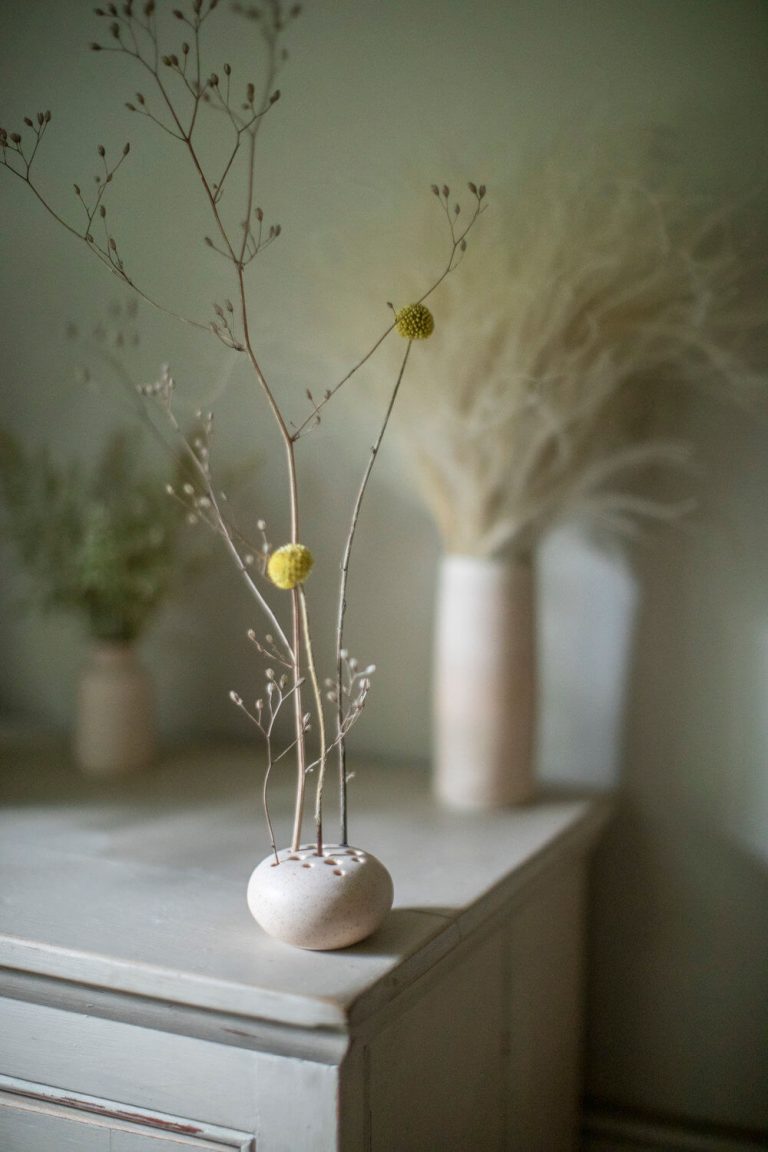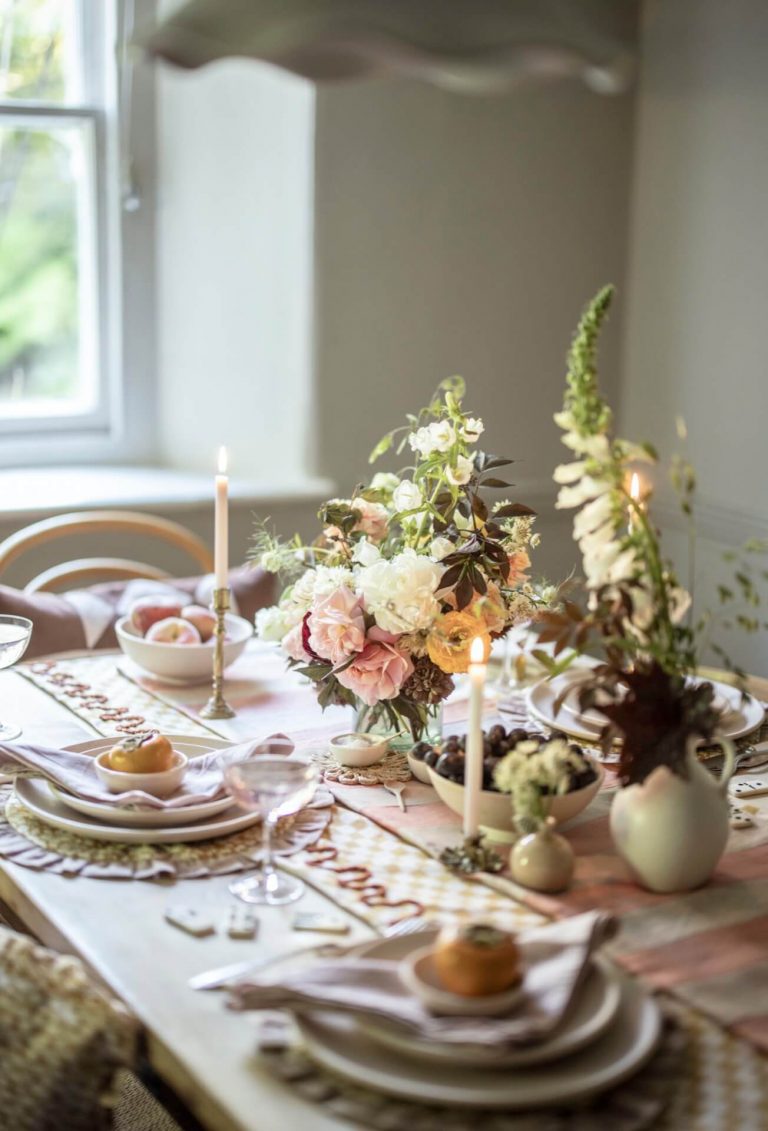After a long, cold winter under flat, grey skies, thankfully spring is just around the corner, and I’m already dreaming of what I could be creating with the first of the season’s delicate blooms.
I don’t consider myself an expert on arranging flowers, far from it. But I do love to spend time putting together simple, mood-boosting floral displays, and spring provides so much in the way of colour and shapes to choose from.

Ikebana inspiration
It dawned on me recently that one of the reasons I love working with flowers is that I like having them in my hands and taking the time to really observe and appreciate them. Contact with nature is known to improve mental health and I find that even a few minutes of ‘flowery faffery’ can bring me into a calm, almost serene state of being.
I’m always on the look out for inspiration and new ways to experiment with putting together flowers and grasses to display at home. Ikebana, the Japanese art of flower arranging, came onto my radar a few years ago.
Part of the Japanese notion of wabi-sabi – the Buddhist belief that there is beauty in imperfection – ikebana is the very definition of a mindful activity and can be incredibly relaxing.


Understanding Ikebana
An important part of the ikebana process is the acknowledgement and appreciation of nature and her seasonal changes. This offers the perfect excuse to get outside, explore your natural surroundings and collect the flowers and foliage that really speak to you. As well as flowers, I like to look for branches and twigs, or simply a pretty leaf or feather. In spring there are buds starting to unfurl, snowdrops, cyclamen and violas beginning to appear through the undergrowth. In summer, the hedgerows are brimming with cow parsley and field buttercups. Come autumn there’s an abundance of grasses and dried seed heads to be found even in scrubland and on grass verges, which are perfect for ikebana arrangements.
It is true that ikebana can be tricker to get to grips with than other ways of arranging flowers – its visual simplicity is deceptive. As ikebana typically involves using fewer stems, extra consideration is needed. The idea is that the characteristic form of each stem, leaf and flower is accentuated by the space between them.


Tips for ikebana-inspired arrangements
If you have many beautiful stems to choose from, it can become a little overwhelming choosing what to keep and what to cull. I tend to add everything I really like, then stand back and observe for a moment, deciding what to take out to pare things back.
It can be helpful to try to find some kind of unity between your stems, be that in their colour or some other form of harmony. Ikebana shapes are traditionally kept minimal and natural. The idea is that the form of your arrangement is found rather than planned, so allow the plants you’re using to inform the shape of your design. I’d recommend carving out some time to yourself. Silence is important – this is supposed to be a time to be quiet and observe nature, so give yourself time to work in a contemplative way to achieve those ikebana-inspired graceful shapes.
While I like to admire and marvel at some of the beautiful ikebana arrangements created by masters of the art form, I would describe my own creations more as “ikebana-inspired.” Rather than getting too caught up in the rules, I follow the three point, triangular structure principal (that is thought to represent humanity, earth and heaven) as a starting point, then allow myself the freedom to enjoy myself and create something a little more wild and rustic. I find I get frustrated otherwise, which sort of defeats the purpose!


Containers for Ikebana
It’s good to allow the flowers to have space around them. Be aware that you don’t have to fill every gap. The flowers will often move and change shape over time, leaving room around them helps show off their natural shape and form.
When choosing a vessel to compose your arrangement in, the key component will be a flower frog, which could be ceramic (which you can fill with water) or a metal pin, which come in various sizes. Metal flower frogs can stand alone if you’re using dried flowers or grasses. Fresh flowers can be placed inside a ceramic frog on its own, but they’re both often placed inside a bowl.
In the past I’ve used dried grasses fixed into metal kenzans placed inside small bowls to create a minimal table arrangement that’s big on impact. For larger, fresh and dried displays, I use a ceramic flower frog inside a beautiful, hand thrown ceramic bowl. The frogs will support stems that are as long as you please (I find vertical height can help give extra wow factor). But I recommend trying not to get too bogged down in using any prescribed method. An ikebana-inspired look can be achieved with long stems placed inside small bud vases, too. Why not let your imagination run wild?
 Flowers perfect for Ikebana by season
Flowers perfect for Ikebana by season
Spring:
- Blossom twigs and branches
- Mimosa
- Muscari
- Snake’s head fritillaries
- Peony tulips
- Butterfly ranunculus
- Snowdrops
- Tete-a-tete daffodils
- Aquilegia
- Lily-of-the-valley
- Geums
 Summer:
Summer:
- Field buttercups
- Ragged robin
- Shepherds purse
- Cow parsley
- Nigella
- Poppies
- Larkspur
- Delphiniums
- Meadow cranesbill
- Field scabious
- Ammi majus
- Astrantia
- Wild carrot
 Autumn:
Autumn:
- Scabiosa ping pong
- Nigellas seed heads
- Lagurus (bunny tails)
- Briza grass
- Miscanthus
- Branches of autumn leaves
If you’d like to give Ikebana a try you can find a selection of flower frogs, bowls and ikebana accessories at Paper Thin Moon.



 Flowers perfect for Ikebana by season
Flowers perfect for Ikebana by season








